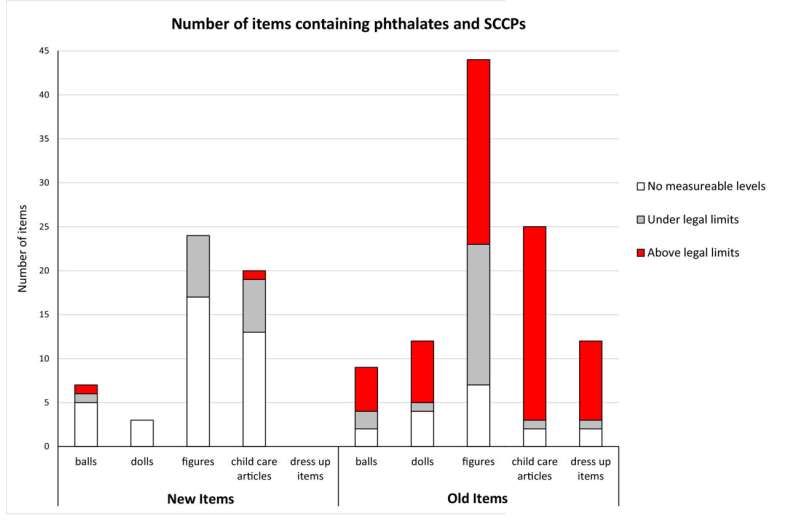
Many of the older toys contained toxins. Credit: University of Gothenburg
Letting children play with hand-me-down plastic toys could constitute a health risk. When researchers at the University of Gothenburg tested a large number of old toys and dress-up items made of plastic, 84% of the items were found to contain toxins that can disrupt growth and development and reproductive capacities in children. These toxins are an obstacle for the circular economy in the future involving reuse and recycling, the researchers explain.
The current use-and-discard behavior is wasteful with resources and a drain on the Earth's finite resources. In 2021, the European Parliament adopted a Circular Economy Action Plan. It encourages the re-use, repair and recycling of products and materials. But the question is whether all products are good to reuse again?
Researchers from the University of Gothenburg have recently published an article in the Journal of Hazardous Materials Advances which shows that old toys and dress-up items may contain toxic chemicals that can cause cancer, damage DNA or disrupt the future reproductive capacities of children.
Toxic chemicals in most old toys
The hazardous chemicals that were discovered included phthalates and short chain chlorinated paraffins used as plasticizers and flame retardants in toys.
Professor Bethanie Carney Almroth at the University of Gothenburg conducts research on the environmental impact of plastics and plastic-related chemicals, and has led the research study conducted at the interdisciplinary Center for Future Chemical Risk Assessment and Management Strategies (FRAM). For the study, researchers selected 157 different toys, new and old, and measured their chemical content.
The study showed that most of the older toys and items (84%) contained quantities of chemicals that exceed current legal limits. A total of 30% of the newer toys and items also exceeded the legal limits. By far however, the older toys were significantly worse.
"The concentrations of toxic substances were significantly higher in the older items. For example, many of the old balls were found to have concentrations of phthalates totaling more than 40% of the toy's weight, which is 400 times over the legal limit," says Bethanie Carney Almroth.
Toxins an obstacle to a circular economy
EU legislation on the chemical content of toys, known as the Toy Safety Directive, regulates the permissible quantities of a number of chemical substances found in toys in an attempt to protect the health and safety of children. At present, the permissible limit values for new toys under the Toy Safety Directive are 0.1% by weight for phthalates and 0.15% by weight for short chain chlorinated paraffins.
"The study indicates that reuse and recycling is not always automatically a good thing. The transition to a more circular economy requires bans and other policy measures that get rid of hazardous chemicals from plastic and other materials. Although the Toy Safety Directive has been crucial in reducing the incidence of hazardous chemicals in toys, it has only been applicable to new toys, not old ones," explains Daniel Slunge, Environmental Economist at the University of Gothenburg.

 Previous page
Previous page Back to top
Back to top







